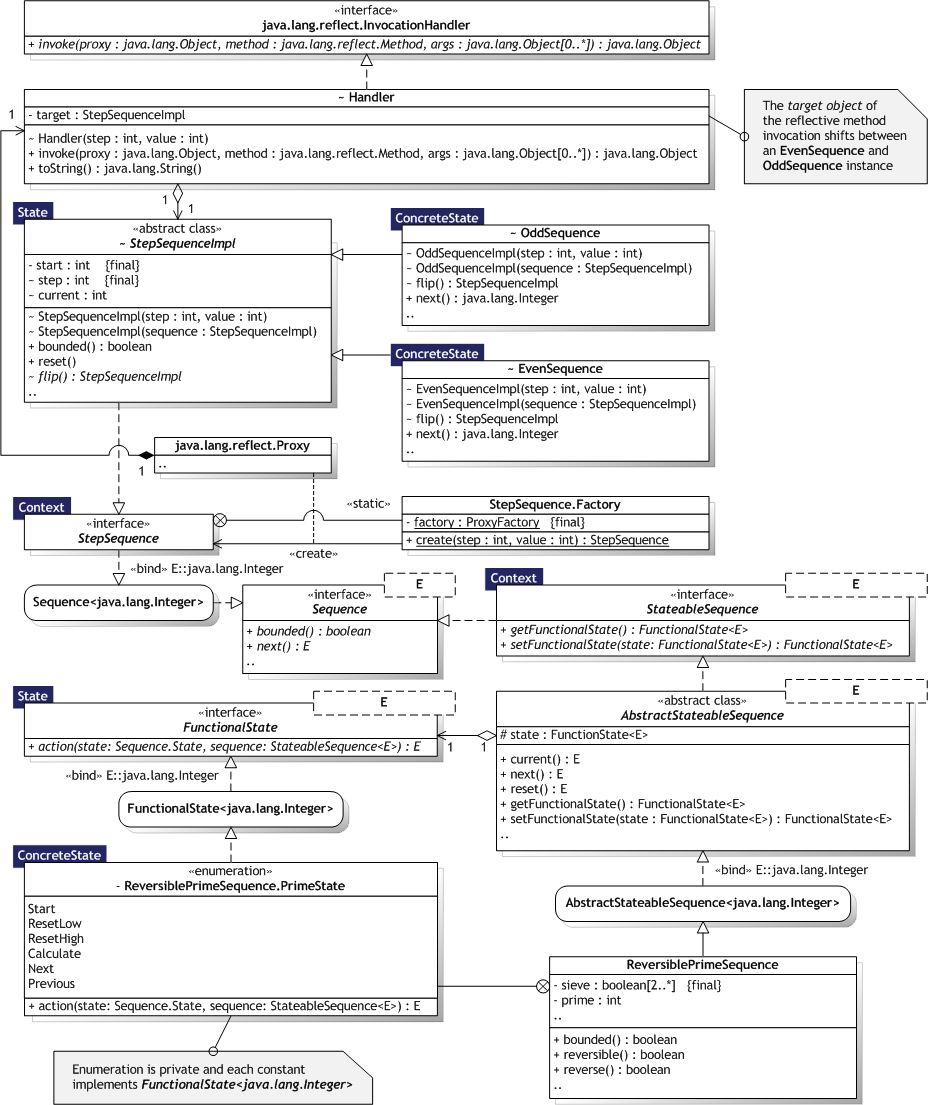
|
Evaluating Software Design Patterns — the "Gang of Four" patterns implemented in Java 6 |
||||||||
| PREV PACKAGE NEXT PACKAGE | FRAMES NO FRAMES | ||||||||
See:
Description
| Interface Summary | |
|---|---|
| FunctionalState<E> | A functional state encapsulates specific state related
functionality of a stateable sequence. |
| StateableSequence<E> | A stateable sequence is implemented internally using
functional state objects to
determine the current functional state. |
| StepSequence | A step sequence represents an unbounded integer value that
is increased/decreased with a given step with each call to
Sequence.next(). |
| Class Summary | |
|---|---|
| AbstractStateableSequence<E> | An abstract stateable sequence implements the basic
traits of a stateable sequence. |
| EvenSequence | The even sequence represents the state generating
even step sequence values. |
| Handler | The handler class is used to perform the actual state change
when the step sequence value goes from even to
odd or vice versa. |
| Main | State tests. |
| OddSequence | The odd sequence represents the state generating
odd step sequence values. |
| ReversiblePrimeSequence | A reversible prime sequence returns with each call to
next() the next prime number in the sequence of
prime numbers smaller than maximum, where maximum
is supplied at construction time, or a previously calculated
prime number with each call to next() after
ReversiblePrimeSequence.reverse() has been invoked. |
| StepSequence.Factory | A factory to create StepSequence instances. |
| StepSequenceImpl | An abstract class representing the basic traits of the
StepSequence interface. |
| Enum Summary | |
|---|---|
| ReversiblePrimeSequence.PrimeState | A prime state represents a stateless
functional state for all
reversible prime sequences, while the actual internal
state and attributes are stored in a given reversible
prime sequence instance. |
Implementations and examples of the State design pattern [Gamma95, p.305].
Intent:
Allow an object to alter its behaviour when its internal state changes. The object will appear to change its class.
For case number 1), the Context participant is represented
by the StateableSequence
interface, and more specifically by the implementing class
ReversiblePrimeSequence.
An abstract class implementing the basic functionality
for any stateable sequence is also defined,
AbstractStateableSequence,
which ReversiblePrimeSequence therefore inherits.
The State participant is represented by the
FunctionalState interface
that describes how ConcreteState participants are
encapsulated and accessed. ReversiblePrimeSequence
defines a private enumeration representing different
ConcreteState implementations corresponding to
sequence behaviour such as initialise, next,
reset, etc.
For case number 2), the Context participant is represented
by the StepSequence type. StepSequence
is a dynamic proxy that represents a sequence that will advance the sequence
value a given step on each call to next(). Internally, it uses two
states types, one representing even sequence values and one representing odd
sequence values. The common sequence value type is the State participant,
while the even and odd implementations represent the ConcreteState
participant. Once the sequence value flips from even to odd or vice versa, the
target object (even or odd instance) will change, not the sequence itself.
This imitates dynamic inheritance as discussed by Gamma et al. [Gamma95, p.309].
Implementation notes:
State transitions are primarily initiated by the different
ConcreteState implementations, but also by the
ReversiblePrimeSequence upon construction and when
reversed.
The Memento implementation
illustrates how to guard access to public state methods in the
GuardedSequenceMemento class.
|
Gunni Rode / rode.dk | ||||||||
| PREV PACKAGE NEXT PACKAGE | FRAMES NO FRAMES | ||||||||